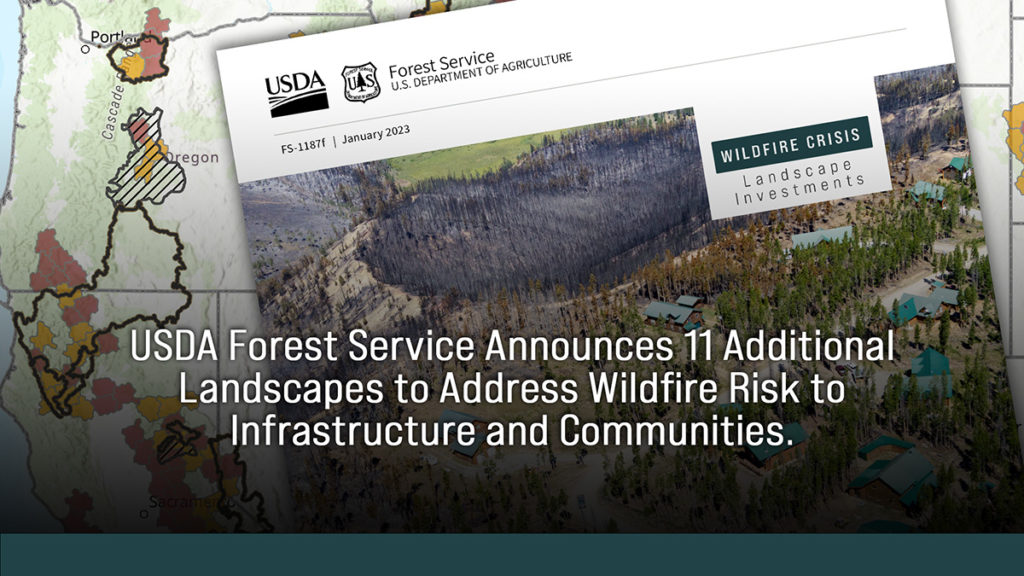Biden-Harris Administration Announces $490 Million to Address the Wildfire Crisis

- Efforts will directly protect at-risk communities across 11 additional landscapes in Arizona, California, Idaho, Nevada, Oregon, Utah and Washington
- Additional projects represent total investment of $930 million across 45 million acres
- “We will use every tool we have to address this crisis and make your communities safer.”
Agriculture Secretary Tom Vilsack announced expanded efforts to reduce wildfire risk across the western U.S. These investments, made possible through President Biden’s landmark Bipartisan Infrastructure Law (BIL) and the Inflation Reduction Act (IRA), will directly protect at-risk communities and critical infrastructure across 11 additional landscapes in Arizona, California, Idaho, Nevada, Oregon, Utah and Washington.
“It is no longer a matter of if a wildfire will threaten many western communities in these landscapes, it is a matter of when,” said Secretary Vilsack. “The need to invest more and to move quickly is apparent. This is a crisis and President Biden is treating it as one. Today’s announcement will bring more than $490 million to 11 key landscapes across the western United States, and will be used to restore our national forests, including the restoration of resilient old-growth forest conditions.”
The Forest Service announced their original 10 landscape project areas last year as part of the agency’s broader strategy to protect communities, critical infrastructure and forest resources from catastrophic wildfire. Combined with these initial landscape investments, the additional efforts being announced today represent a total USDA investment of $930 million across 45 million acres.
This work spans 134 of the 250 high-risk “firesheds” identified in the Wildfire Crisis Strategy and will mitigate wildfire risk to around 200 communities in the western U.S. Firesheds are areas where wildfire is likely to pose the greatest risk to communities and resources.
The landscapes for these additional investments were selected based on the potential for wildfire to affect nearby communities and buildings, with a focus on protecting underserved communities, critical infrastructure, public water sources and Tribal lands. USDA also considered more than 3,000 comments from 11 roundtable meetings held in the first half of 2022, which included partners, industry, Tribes and other stakeholders.
See related article: Biden-Harris Administration Releases Blueprint to Decarbonize America’s Transportation Sector

“We are building on the investments announced last year and by expanding the Forest Service effort to cover 21 landscapes where communities, critical infrastructure and our natural resources are most in need of protection from the growing threat of wildfires,” said USDA Undersecretary for Natural Resources and the Environment (NRE), Dr. Homer Wilkes. “This is part of our agency wide focus to reduce wildfire risk across the country. We will use every tool we have to address this crisis and make your communities safer.”
Secretary Vilsack is also directing the Forest Service to use and prioritize a suite of provisions authorized in the Bipartisan Infrastructure Law to more quickly apply targeted treatments to the high-risk firesheds identified in the Wildfire Crisis Strategy, while opening up additional opportunities to pursue science-based reforestation, restoration of old growth forests and recovery of other areas impacted by wildfire.
These treatments are required to be ecologically appropriate, maximize the retention of large trees, protect old growth, and to consider possible effects on historically underserved communities and Tribes. Treatments are also to be carried out collaboratively alongside participating communities and partners.
“Doing this work in the right place, at the right time, and at the right scale, combined with the use of emergency authorities, will accelerate our planning, consultation, contracting, hiring and project work to reduce wildfire risk and improve forest health and resilience,” said Forest Service Chief Randy Moore. “Collaboration with Tribes, communities and partners will remain a priority, and we will continue to use the best available science when carrying out this important work.”












